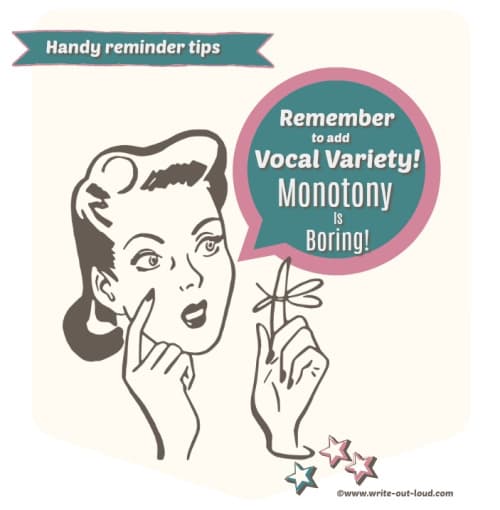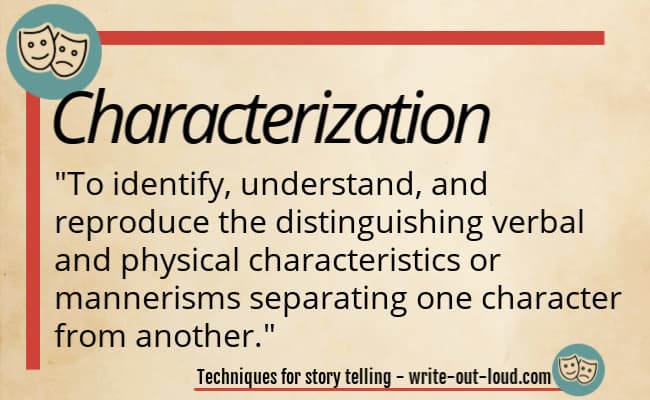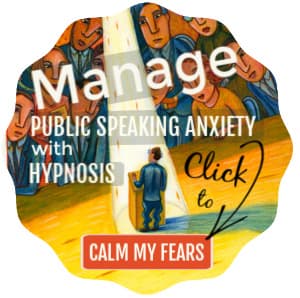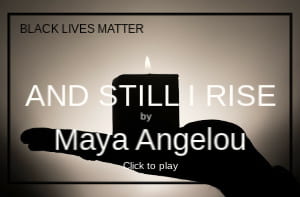- HOME ›
- How to use humor in speeches
How to use humor in speeches
What gets a laugh? What doesn't and, why?
By: Susan Dugdale | Last modified: 10-02-2023
Have you ever wondered how to use humor effectively in speeches?
What gets a laugh? What doesn't, and why?
Most of us, me included, would love to effortlessly entertain as well as inform when we present. We know and appreciate the gifts humor brings.
There's audience rapport: their bright-eyed eagerness to hear what you have to share, their easy readiness to laugh, the way they lean forward to catch your next comment...
Benefits of using humor effectively
Humor creates a bond, a sense of closeness. The audience relaxes. They're at ease. They feel good, energized, alert and eager to hear what you have to say. They like you, and because they do, they're more likely to remember what you talked about later.
If your subject is serious they'll appreciate you for leavening it with well-placed appropriate humor to break the tension.
Use humor effectively and you will leave the audience happy and impressed with your speaking skills.
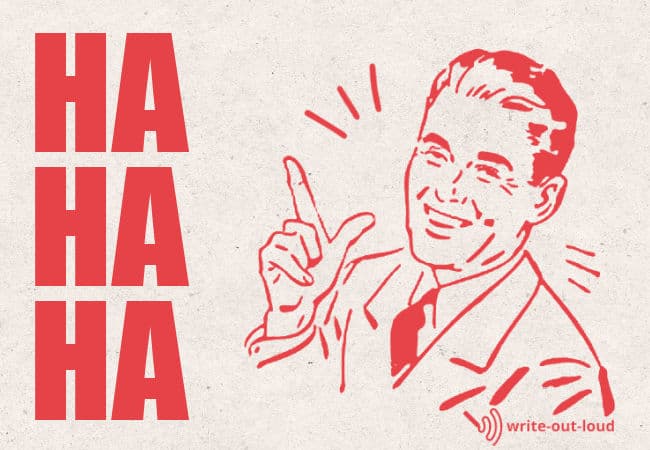
But what happens if your audience doesn't respond?
What if your carefully crafted laugh lines aren't
caught up, and they fall to the floor, to wither and shrivel?
What if your audience shuffles in their seats, folds their arms, raises their eyebrows, and looks away?
Help to avoid the pain of NOT being funny
Use the links below to move around this long page easily. They'll give you a good starting point toward understanding how humor works.
- Know your audience
- Safe speech humor
- Integrated humor
- How to rehearse humor
- The difference between a joke and contextual humor
- And lastly, for those of you who are unsure whether or not to risk adding a laugh: The benefits of using humor in a speech.
1. Know your audience
Plan your humor around your audience. Always.
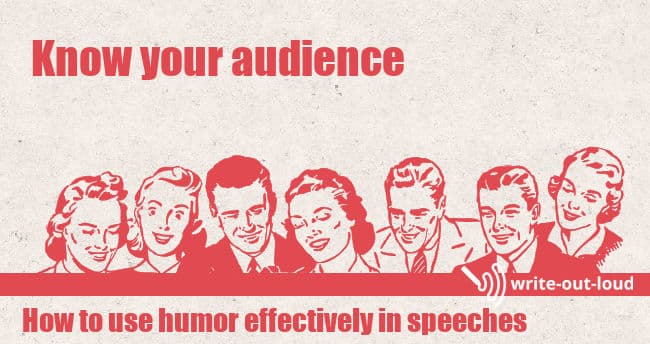
To make humor work well you need:
- a demographic overview of your audience: those factors may include age, gender, religion, ethnic background, class, sexual orientation, occupation, education, location (where a persons lives), membership of specific groups ...
- an understanding of how they view your speech topic and the reason you have for giving the speech.
They may be a friendly audience: well disposed toward your topic. Therefore what you say will be in accord with their own beliefs and they'll chuckle along merrily.
They may be apathetic: not care actively one way or the other about your subject. If that's the case it's your task to let them know what's in it for them, to make them interested.
They may be uninformed, ignorant on the topic. This audience needs educating, ie. background information, before they'll appreciate what you have to say on your topic.
They may be hostile: actively against whatever it is you're wanting to share. And this audience needs to know you respect and understand their point of view before you launch into your own.
A humorous story, anecdote or joke told without knowledge of your audience because you think it is
funny is dangerous. They are often the ones likely to
lurch sideways, leaving you stranded.
How do you know they won't find it offensive?
How do you know they'll understand it at all?
Humor varies from person to person and group to group. What we find funny is not always a reliable indication that everyone else will find the same type of humor amusing.
Do some digging. Ask. Find out as much as you can.
2. Use safe humor
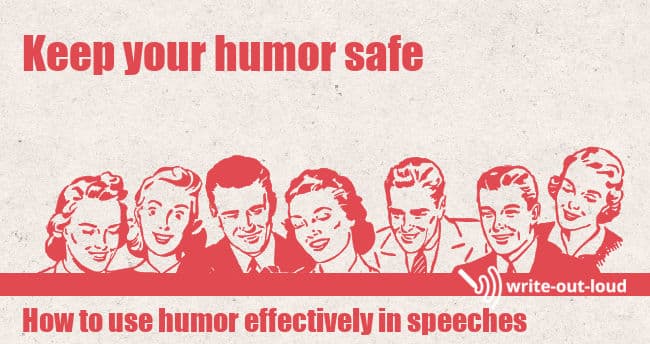
The audience is not your target, usually! ☺
Use humor that doesn't use the audience as the butt of the joke.
This is not the time to make jokes about audiences so thick their brains have the consistency of rapidly setting concrete or similar observations.
Avoid dividing an audience
Use humor that doesn't isolate and target a segment of the audience: all the blondes, males, females, English speakers, people of Italian descent, people who have a commerce degree, or Sunday afternoon yoga practitioners...
A descriptor that separates and intentionally sets one group up to laugh at another is, as my mother would say, 'not nice dear, not nice at all'.
Keep out of the gutter
Use humor that doesn't rely on 'coarse' language or profanity to make its point.
For instance, a string of loud beautifully enunciated f**k, f**k, f**kity, f**ks may be hilariously amusing in some settings, but a serious lapse of judgment in others.
Stick to safe subjects
Use humor that avoids taboo subjects: religion, politics, race, class or sex.
Focus the laughs on yourself
Using humor effectively often means using yourself as the subject, but only if it's relevant to your topic, and done in a kindly way.
Nobody wants to hear or see you putting yourself down harshly. You may laugh at your foibles or quirks publicly but not prostrate yourself for a whipping in front of an audience. That will embarrass them.
When you poke fun at yourself in a balanced, truthful way you are giving the audience permission to laugh with you, not at you.
You are also inviting them to identify with you, creating openness and trust. Your audience will be more likely to listen because you're reflecting or showing them an aspect they know to be true of themselves, as well as you.
These stories do not have to be about big life events to work. Those small incidents where we are brought up short are very effective in the right place.
The chocolate yoghurt faux pas
For instance, here is a story about what happened one late afternoon, after I'd finished teaching for the day, and had picked up my son, then aged four, from childcare.
On the way home we called into the supermarket. We were standing in front of a chiller cabinet full of frozen desserts: ice cream of all flavors, different sorts of gelato, and yoghurt.
A woman next to us opened the door and took out a large tub of chocolate flavored yoghurt. My son was amazed. He looked up at me, and then told her loudly, "My mother says that's full of sugar and complete rubbish!"
Yes. Quite. Hmm.
I was deeply embarrassed as was the woman with the rubbish yoghurt in her hand.
We're human. We all have stories about ourselves to use. ☺
Laugh about what you know
Use subjects you've earned the right to joke about.
For example an over weight person may make comments about being large, a disabled person can joke about the difficulties they encounter on a daily basis or a woman can laugh about the trials of child bearing, provided she has had a child.
A safe guideline is, if you don't know it, as in having lived it, don't jest or make light of it.
Test and refine. Is it really funny?
It is better to have several strong anecdotes in your presentation rather than a string of weak ones.
Always rehearse and test the humor you plan to use. (Scroll down for rehearsal tips.)
To test have several people listen and give you honest feedback. Listen to it.
It maybe that the subject is wrong for the situation,
or perhaps your delivery needs work, or your language choice needs
altering. Any of those could cause a humorous throwaway comment or a story to fall flat.
3. Integrating humor
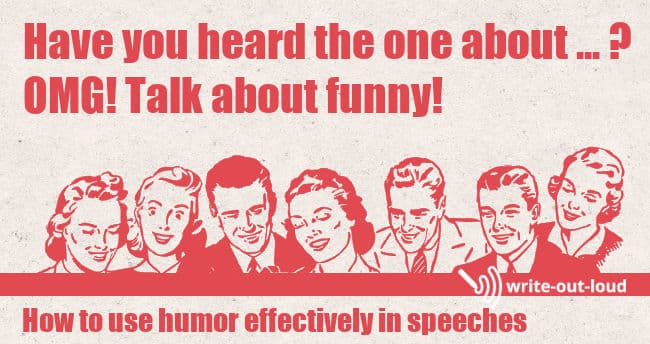
Integrate any joke/humorous remark or story you use into your speech or presentation.
If you're thinking of telling the joke because you think it's a good one and bound to get you laughs but it has nothing to do with your speech topic, leave it out. It might be hilarious, but it is not relevant.
Unless you find a plausible, believable way to link the material into your subject, forget it. Please.
Introducing humor
And if you do want to tell a joke or add humor and IT IS relevant make sure it is not introduced along the lines of:
'Have you heard the one about ...?'
'This is really funny. You're going to howl with laughter.'
'There was this Irishman/Scotsman/Australian...'
None of these openings show the humor is blended with your own material and the second one is particularly nasty if your audience sits poker faced!
Stick to your speech purpose
Unless you were briefed to be a comedian, don't attempt it. This doesn't mean don't use humor. It means stick to your speech purpose and find the humor within that subject matter. The audience is not expecting a stand-up comedy routine from you.
Giggle, chortle and smile

Read content suggestions (with examples) about what goes into making a great funny speech.
Choose yourself a light-hearted subject to talk on from this list of 60 fun speech topics.
Don't want a serious persuasive speech idea?
Try one of these 105 fun persuasive speech topics!
What about a not-so-serious demonstration speech?
Give your audience a giggle with a topic chosen from these 188 funny how to speech ideas.
Blend your humor
Weave your humorous material through your speech while keeping the ratio of laugh-lines to information balanced appropriately for your topic, audience, the type of speech and its purpose.
For example, if your speech is primarily to entertain rather than inform, it may be right to use more humor. Judge each situation carefully.
4. Keys to rehearsing humor in your speech
Use an expressive voice
Live into the story you are telling to make it seem as if it were happening again in the 'here and now'.
If an angry voice is needed. Use one. If wheedling is asked for. Whine, like you really mean it. This gives the audience the 'feel' of the situation. They will grasp it and its emotional content more quickly.
If you need a hand, you'll find it here:
How to develop and use an expressive voice.
These simple vocal variety exercises covering pitch, tone, volume and rate will help you identify where you need to place your effort.
Use simple pared down language
The less complicated the set-up and story, the more direct it is and the less chance your audience has of misunderstanding.
For help with how to enter or set up a story check this page on story-telling step-ups. You'll find examples of what not, and what to do to.
Remember the rule of three
The rule of three works in all areas of presentation. It can be three examples to illustrate a point. It could three repetitions of the same word or phrase for emphasis, a device often used in oratory.
Or it could be three
characters in an anecdotal story e.g. a variation on the classic: An Irishman, Australian and an American ...
Three in storytelling is a naturally believable number whether it be words to describe people and their actions or, the events themselves.
The first usage sets whatever it is up in the audience's mind as possibly believable. The second, reinforces it and by the time the third instance comes along, the audience has accepted it as truth.
Three, works!
Practice, practice, and then, practice some more
Practice telling your story in as many ways as you can and listen to yourself.
What happens if you speed up here, and slow down there?
What happens if you emphasize this word instead of that word?
As a general rule comedians point up the punch line. They give a cue to the audience that it is coming, preparing them to listen and laugh using a combination of slowing down, pausing and emphasis.
It's called finding 'the beat'. Miss it and nobody will laugh. Find it and the same joke that previously bombed will fly. The only sure-fire way to locate it is through practice. After enough, you'll sense it and know when to slow, pause and stress a word.
To find out more about the dynamic inter-play of speech rate and pausing check in here: speech rate and pausing in speech.
Record yourself
- Is your lead-in or set-up smooth?
The 'lead-in' is the integration of the one liner, story, or anecdote with the body of your speech. It is the bridge between your core information and the humor.
Part of learning how to use humor effectively is to make it believable by introducing it as a part of the general flow of your speech. This makes it truthful in the ears and eyes of your audience. It also sets up the element of surprise as the audience will not be expecting your cunning comedic twist. A smooth set-up helps you achieve that. - Is your voice expressive?
- Is your language simple, effective and easily understood?
- Have you pointed up the laugh line?
- Is the laugh line clear?
What's funny? Is it you or your story?
Make a distinction between the humor and yourself.
Are you funny or is the story you are telling funny?
For example, a comedian does not laugh at his own jokes as it breaks the illusion of truth.
When you laugh at your own material you are on the outside of it, looking in, rather than BEING it.
Use simple large gestures
If you are going to incorporate acting into your story practice using clear decisive gestures rather than a flurry of small ones.
Think mime. It crosses audience boundaries easily through involving your whole body in the action.
Everybody, regardless of who they are or the language they speak, understands the body language of weeping in despair, pulling your hair out in desperation, or swooning with love.
For an introduction to using gesture in speeches check this page on characterization techniques. You'll find exercises to help you.
5.What's the difference between using humor and telling a joke?
Humor is usually part of its context. In other words it is derived from the situation or setting.
Here's a wonderful and true story to illustrate.
Instant karma
In
one of my classes I had a very mouthy, opinionated student. Whatever
the subject he knew more about it than anybody else and he always made
sure everybody knew, he knew. He corrected, interrupted, and sometimes
jeered at his classmates.
One day in the middle of yet another unasked for torrent of information, a hanging pot plant above him let go of its hook in the ceiling. It crashed spectacularly to the floor showering him in earth, plant and shards of pottery. The class, dissolving into mirth, fell off their chairs laughing and I heard someone say; 'I reckon that's instant karma, Jason.'
Fortunately only his pride was hurt.
A joke is often isolated from or very loosely connected to what is happening. It tends to be a pre-formatted story following known, well worn lines.
Example:
How do you confuse a blonde?
Answer: Put her in a circle and tell her to sit in the corner.
6. The benefits of using humor effectively
When you use humor well you benefit, along with your audience.
Here's how:
- Humor breaks through barriers. Laughter can transcend age, race, gender, belief or class barriers.
- Humor relaxes your audience and puts them in a receptive mood. After you have made them laugh, they are more likely to want to listen to you!
- Humor alerts your audience to listen. They become more interested in what you're saying than what happened prior to them listening to you or what is going to happen afterward. It brings your audience into the happening-here-and-now.
- Laughter adds 'juice' to a presentation. It can enliven potentially dry or dull material.
- Humor releases tension.
- Humor binds people together: that is, humor based on common experience unites a group.
For example, almost every profession has its own humor. For instance, there are lawyer, teacher, doctor, computer tech, and so on, jokes.
Likewise, every relationship has its jokes. There are husband jokes, wife jokes, daughter, son, baby, mother-in-law, father-in-law, boss...
More about how to use humor effectively:
Find out about differing types of verbal humor.
Your audience will appreciate it.
When you've finished discovering the joy of strategically using a sprinkle of malapropisms with a side serving of irony, try some physical humor.
And continue to ...
PRACTICE
telling your stories, PRACTICE timing and PRACTICE looking for the
comedic or humorous element in all the events of your life.
If you're considering entering a humorous speech contest, please don't do as I did!
Read about what happened when I overlooked a critical element in my preparation. This was a humorous speech lesson I'll remember.
References
Understanding how and why humor works:
- What makes something funny? by Ben Healy, March 2018, The Atlantic
- A quest to understand what makes things funny by Shane Snow, April 1 2014, The New Yorker
The psychological and physiological benefits of humor:
- The laughter prescription - American Journal of Lifestyle Medicine, Dexter Louie, BA, Karolina Brook, MD, and Elizabeth Frates, MD, 2016 Jul-Aug; 10(4)
